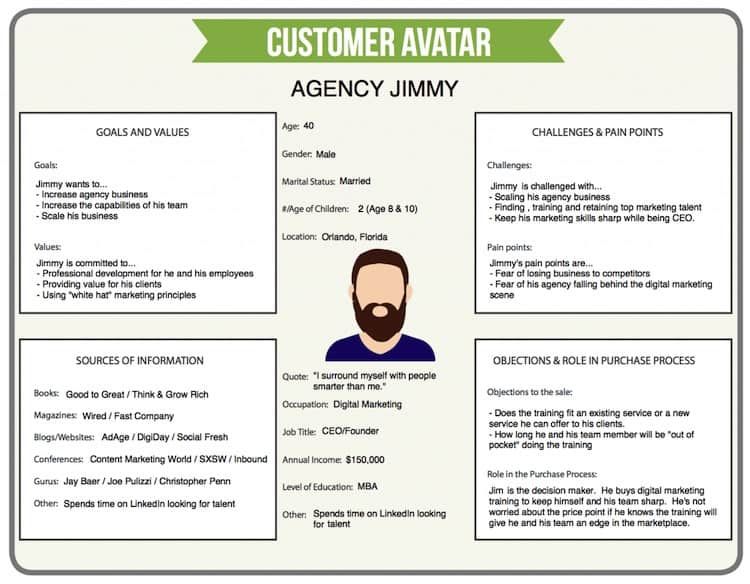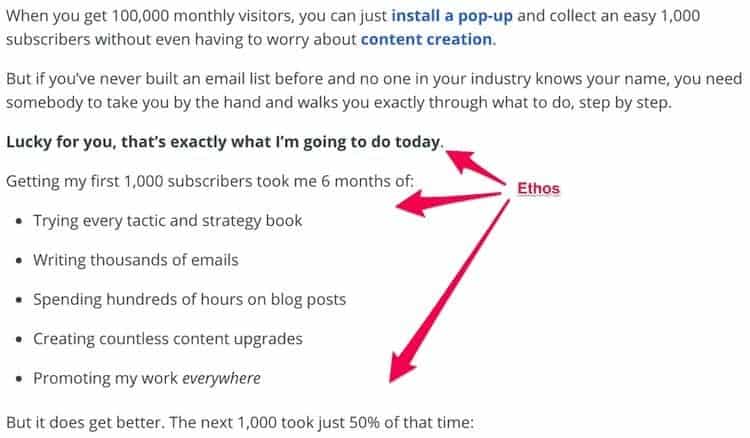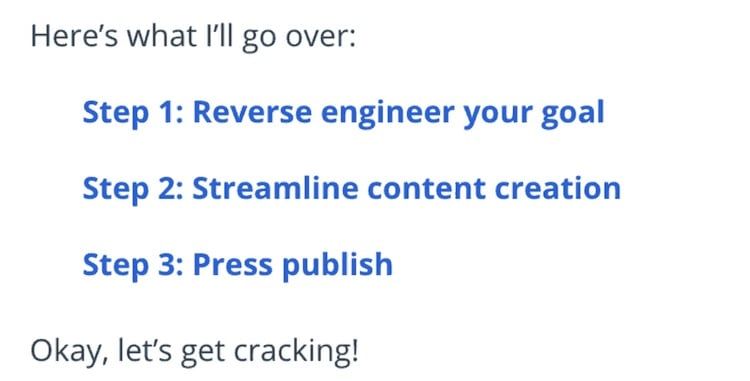Are you tired of writing articles that look bland and unappealing?
Do you want to write articles that stand out and connect with the reader?
Then I have good news because today I’m sharing seven techniques I have learned running my freelance writing business for the past four years.
These are the same techniques I use writing for some of the biggest publications in the marketing industry.
There’s a lot we need to cover, so let’s get started.
Speak the Truth
How many times have you written a piece because “you had an idea” in your mind?
If you are like me, it happens more often than I’d like to admit. As a beginner, I used to do it all the time because I thought that’s what content writers do.
I used to pitch ideas that I had no idea about. By the time a publication accepted it, I had to scramble a bunch of content rehashed from other sites and repackaged them into a new piece.
There’s nothing wrong with doing research and analyzing what others write, but basing an article on such bland foundations is a recipe for mediocrity.
I was writing based on random ideas I thought were cool, not on something I had to say.
From these mistakes, here’s what I have learned:
The job of a content writer isn’t to come up with ideas, but to find the truth and write about it.
This is an idea I learned from Steven Pinker, a famous Canadian linguist and psychologist, who explains this concept in the book The Sense of Style:
The writer can see something that the reader has not yet noticed, and he orients the reader’s gaze so that she can see it for herself. The purpose of writing is presentation, and its motive is disinterested truth. It succeeds when it aligns language with the truth, the proof of success being clarity and simplicity.
In this excerpt, Pinker is correcting writers just like me who used to improvise whenever they write about a topic. Instead, Pinker proposes that “the writer knows the truth before putting it into words [so] he is not using the occasion of writing to sort out what he thinks.”
For Pinker, the “prose is a window onto the world.” Your job is not to argue or impose a truth, only to present it.
If this sounds a bit messianic, as if you are the savior of the readers, then I can assure you it’s not what Pinker is saying. On the contrary, Pinker believes:
The reader is competent and can recognize the truth when she sees it, as long as she is given an unobstructed view. The writer and the reader are equals, and the process of directing the reader’s gaze takes the form of a conversation.
Instead of dumbing down ideas or imposing them onto the reader, the writer explains them with clarity.
To speak the truth—your truth—you want to write your articles based on your knowledge, your experience, and your opinions.
Your goal is to project authority and expertise.
Share your truth, and get out of its way. That’s how you create authoritative content.
Show Your Expertise
Forget passion. Unless you sell your grandma’s knitted sweaters, no one cares about your passion.
Whether you sell software, products, or a service, you’ve got something no one else has. You have a set of skills no one else has, sort of like Liam Neeson in Taken, but less violent. 😜
If you have the expertise, put it into (digital) paper and share it with the world.
As I’ve said in my article on common writing challenges, you don’t have to be an expert to write about a topic. Being an “expert” is an ambiguous concept no one can define. Worse yet, there are many “experts” who are a bunch of sweet talkers with no substance behind it. Forget about being an expert.
You only need expertise.
Your expertise—that is, the skills that come from experience—is what makes your content shine. You can immediately tell when you read an article that was written through the author’s expertise.
I’m talking about people like Caples Hahn in Tested Advertising Methods. Or Roy Peter Clark in Writing Tools. Or Dan Ariely in Predictably Irrational.
These are people who spent their decades, entire careers even, developing the knowledge necessary to write about the topics of their books.
Write about what you know. I can assure you that when you do so, your articles will seem ten times better than if you are writing based on research (i.e., regurgitating other people’s content).
Writing an article based on your expertise doesn’t mean you can use technical jargon no reader understands—unless if you write for trade publications whose readers are all professionals like yourself. You always need to write in a way the reader can understand and enjoy (more on that later).
But if you can pump enough expertise from your knowledge well while still writing in an enjoyable manner, you will hit jackpot.
Do you fear your competitor paper writers will steal your “magic sauce”? Do you want to protect your unique tactics, so your potential clients won’t take them and use them on their own?
Forget about it.
You have no competition. It’s all in your head. Everyone is too busy with their own crap, so create content like there’s no competition. Because there is none.
And your clients? They are also too busy trying to figure out things on their own to “steal” your tricks and tips. It’s the other way around: your readers will love you for your help. They will respect you; they will want to work with you.
Open the doors to your expertise, and you will open your reader’s hearts (or something less cheesy).
What If I’m Not an Authority?
I’m assuming you know what you are writing about. Even if that means you know how to use the oxford comma the right way. Or if you know how to create social media titles that people love.
If you aren’t an expert, then all you have to do is borrow the expertise.
- Quote experts. You can take their quotes from other articles, podcasts, videos, or books. Better yet, send them emails and ask them for unique answers.
- Interview experts. Talk one-on-one with them, extract their knowledge, and distill their ideas. This is like “quoting experts” but on steroids.
- Hire an expert to write for you and then edit their content. Use Upwork to find freelancers and see if they are interested in doing it.
- Use stats and examples. These work as proof that your opinion has a basis in reality. It’s not as powerful as the previous three ideas, but it’s better than stating something “because you think so.”
Write Simply
For online writers, attention is like the new gold standard. The more companies want it, the harder it is to obtain it, and the more it is valued.
You have millions of blog posts published every day. You have billions of hours uploaded on YouTube. You have competitors fighting for your readers at every corner.
The only solution is to stand out. But how can you do that? I think the answer is to write simply.
I believe simplicity in writing can be boiled down to one idea:
The words you use must help each other, as well as the reader, understand what you are saying.
(As a corollary, any word, phrase, or sentence that gets in the way of your ideas should be cut down.)
I can speak from experience when I say that most often, writers commit this crucial mistake when they add words just to look cool.
Man, I can tell you, as a non-native English speaker, whenever I learn new words or expressions, I love sparkling them everywhere I write. I often have a “word of the month,” where I repeat it over and over every time I write. Some common words or expressions I’ve seen myself abusing include:
- Obviously.
- Undoubtedly.
- Regardless.
- Yet.
- Neither/nor.
I’m like a kid who relishes on new toys. Except that instead of toys, words make me happy. I guess that I just want to sound cool. Maybe I want to show others I can write like an old-school Ivy League graduate would speak (think William F Buckley Jr.).
When this happens, I put my writing in second place. My need to experiment on my writing ends up making my content look odd. There’s nothing wrong with experimentation, except when it ruins your writing.
Similarly, you want to cut every that gets in the way of your ideas. These obstacles can include the discriminate use of:
- Adverbs.
- Parentheses.
- Comparisons.
- Examples.
- Adjectives.
- Other random words or expressions.
When you write, forget about these problems (see below “Write First, Edit Later”). When you edit, you want to take a fresh look at each of these elements. Think of yourself as the police of your own writing.
(This is why you want to have an editor check your content. If you don’t have one, ask for feedback or hire one to help you out. If you don’t have the money, use a tool like Grammarly, especially its premium version, which comes with extra suggestions.)
If you are like me and you know you tend to use catchphrases regularly, check for them. Whenever I see myself wondering about a word or phrase I think I’ve used in one article a few times, I use the search bar to check the number of times I’ve used it.
The word “help” is one of the most common ones I use, so I often check for it. There have been times where I found it over a dozen times in one piece, something that leads me to change it for other words or expressions.
Don’t let your words get in the way of your writing. Simplify it and make it pristine. Your reader should be able to enjoy every paragraph of your writing without them knowing it. That’s the true mark of a great writer.
There’s a saying that goes: “First do it, then do it right, then do it better.”
Similarly, I’d say: “first write it, then write it right, then write it better.”
When in Doubt, Follow Hemingway
Ernest Hemingway once said, “A writer’s style should be direct and personal, his imagery rich and earthy, and his words simple and vigorous.”
He’s known for his great prose, simple and concise. But the reason why he’s considered a revolutionary writer it’s not because of his writing style, but because he shattered the Victorian style many writers of his era used. As this article explains:
Before Hemingway began publishing his short stories and sketches, American writers affected British mannerisms. Adjectives piled on top of one another; adverbs tripped over each other. Colons clogged the flow of even short paragraphs, and the plethora of semicolons often caused readers to throw up their hands in exasperation.
Take a look at William Faulkner, a Nobel Prize-winning writer, describing a tired person:
He did not feel weak, he was merely luxuriating in that supremely gutful lassitude of convalescence in which time, hurry, doing, did not exist, the accumulating seconds and minutes and hours to which it its well state the body is slave both waking and sleeping, now reversed and time now the lip-server and mendicant to the body’s pleasure instead of the body thrall to time’s headlong course.
Compare that description to Hemingway’s:
Manuel drank his brandy. He felt sleepy himself. It was too hot to go out into the town. Besides there was nothing to do. He wanted to see Zurito. He would go to sleep while he waited.
When you are in doubt, remember to follow Hemingway. Cut all the crap fat from your articles. You’ll do a favor both to yourself and to your readers.
Write First, Edit Later
There’s no other way to say this, but your first draft will stink. It always does. Read writing advice from many famous writers, and you will see they all come back to this issue.
“The first draft of anything is shit.” – Ernest Hemingway
Get over your insecurities and write your article anyway. Write the words like you don’t care. What matters is that you put your ideas down, that they flow and make sense. Make sketches of your stories. Forget about what others may think because they won’t read it.
Once you are done writing, edit like you care.
- Polish your ideas.
- Take out any extra sentences or words that get in the way of your ideas.
- Improve your grammar.
- Read your article as if someone else wrote it. Sometimes, it will feel that way.
Then, add images, links, quotes, stats, and the whole nine yards that make an article shine. Hire someone if you’re too lazy to do it. But this is where you can show you genuinely care about your reader.
And, as much as you will hate it, remember what Stephen King said:
You will have to kill your darlings. Some ideas you love, ideas that took a long time to write down and that make you proud, may not fit into your article. So kill them. It sucks, but it’s for the best of your article—and your reader.
Just write. Write until you have nothing else to write about. Then edit. It’s simple as that.
When In Doubt, Write for Yourself…
There’s a point in your article where you will ask yourself: “should I write this?”
This is the moment where you start doubting yourself, trying to appeal to the reader, to the editor, or to anyone who you think you should kneel to.
In such conjunction, the only answer is to write for yourself.
I know some will say that’s irresponsible and ridiculous; if all writers did is to write for themselves, most writers would write about pizza and football, in a conversational, immature manner. “Where’s the art of writing?” they’ll ask.
The idea behind this technique isn’t to do whatever you feel like. On the contrary, it’s to adopt a philosophy of writing, one that guides your writing as a way of expressing yourself.
That means, write down what you think is the most representative of yourself.
Let’s say you’re writing for a site that has a formal and authoritative tone and whose readers are well-read, educated people. As you’re writing the article, you feel like adding a funny, silly, or sassy phrase or sentence in your content but doubt that it will be accepted.
In such circumstances, you will probably take that out of your content and forget it. Naturally, you believe that’s the most responsible thing to do. But as you can probably tell by reading sites like The Atlantic or The New Yorker, these sites also feature writers whose unique style isn’t as formal as you’d expect.
Their styles descend from that self-amusement most writers follow—the spirit of writing for themselves.
As I suggest in the next technique, you should also write with the reader in mind. But before anything, you’re a writer, and as such, the exercise of writing should be a self-expanding activity, one that helps you express yourself, whatever the topic which you write about.
When you write for yourself, you will start to amuse yourself. Your writing will be both spontaneous and funny, personal and relatable, professional and honest.
As William Zinsser says in On Writing Well:
Don’t worry about whether the reader will “get it” if you indulge a sudden impulse for humor. If it amuses you in the act of writing, put it in.
“Who am I writing for?” is a fundamental question, and it has a fundamental answer: You are writing for yourself.
…and Don’t Forget to Write for One reader
When you write an article, you are expecting—if not hoping—someone will read the entire piece. In some cases, like on my own, you are writing to attract traffic, so if you don’t get eyeballs in front of your article, you are failing, regardless of the quality of your content.
As a content writer, you should always keep your personal writing spirit, as shown in the technique above, but you can’t also forget to write with the reader in mind.
That is, write for one person.
- Your reader.
- Your client (or your customer’s client).
- Your colleagues.
To make this person clear, marketers use customer avatars.
A customer avatar is an abstract representation of your ideal reader you want to write to. This avatar will help you create content that best represents their interest, problems, and needs.

You can make this avatar as complicated or straightforward as you want to make it. The most essential characteristics any customer avatar have to include:
- Demographics: Like age, gender, education level, marital status, income.
- Psychographics: Like goals, values, challenges, and pain points.
- Name: Give it a name.
- Face: Add a photo of this avatar.
For each of these characteristics, you want to be specific. You won’t be writing to a woman between 25 and 34 who has 2.5 cats; you’ll do it for a 28-years old woman who has one cat and one dog, and who also likes to listen to jazz at night.
When you write, write for one person.
To find this information, you have two options:
- Qualitative research, including surveys, 1-on-1 interviews, and data from sales and customer support people.
- Quantitative research, including using tools like Facebook Audience Insights.
The more complex your goal, like generating leads to an enterprise company, the more specific your avatar should be, and the more information you should have. If you have a simpler strategy, one focused on attracting a few thousand visitors to your personal blog, then you can use simpler avatars.
Think about this person as if you knew them. That’s where adding human touches to the avatar, like a real name and a photo, helps a lot. You want to literally imagine that avatar as you write. Regardless of your tone—formal or informal—you want to write for that person.
You can imagine the avatar as a friend of yours, as a potential customer, or as a conference attendee; whatever the case, write for one person.
Use the Aristotle Technique
The Greeks developed the art of rhetoric 2,500 years ago. From the many orators of their age—Demosthenes, Dinarchus, etc.—Aristotle stands out as the most memorable.
While Aristotle is mostly known for his philosophical teachings, he also developed a technique for effective communication, which people now call the “Aristotelian triptych”—or is I call it, the Aristotle Technique.
In his Treatise of Rhetoric, written around the mid-4th century BC, Aristotle developed a system for effective communication, which consists of the following three parts:
- Start by gaining your credibility—the “ethos.”
- Continue creating an emotional bond with your audience—the “pathos.”
- Finish by developing a pattern for reasoning—the “logos.”
While the Aristotle Technique has many philosophical ramifications, you can still use the ethos-pathos-logos trifecta by structuring your content in the following manner:
- Tell your audience what you will tell them.
- Tell them what you want to tell them.
- Tell them what you told them.
This three-part structure follows the order in which you organize your content. That means:
- In your headline and introduction, tell the reader what you will share with them in the rest of the article.
- Throughout the article, explain everything you told them you’d tell them.
- In the conclusion, summarize what you told them, which is what you said you would tell them in the introduction.
If you analyze the articles all successful writers create, you will find all of them use the Aristotle technique—consciously or not.
Look at this guide. I started with a catchy intro, where I said what you will learn in this guide. More importantly, I say these are the techniques I’ve used to write in authoritative sites, thus gaining my credibility (my ethos).
Then the rest of this guide is all about giving value and creating an emotional bond with you (the pathos).
At the conclusion, which you can see below, I briefly sum up what you learned, helping you get a clearer understanding of the concepts explained here (the logos).
Let’s take a look at another example, this one from Niklas Goeke, a writer for Sumo, about content creation. Here’s his intro:

Not only he starts by telling you what he will teach you, but he also goes to explain what he did, gaining all the credibility he needs to start teaching his ideas.
Then, he finishes his intro by summarizing the three main ideas he will teach.

The rest of the article explains with detail the steps he promised at the intro (the pathos). At the conclusion, he summarizes the lessons from the article (the logos), plus a lead offer to entice a signup.

That’s how you use the Aristotle Technique and how you must use it.
Say what you will talk about. Talk about it. Recap what you just told them.
Start Writing Articles Like a Professional Content Writer
It doesn’t matter if you write an article in 2 hours or 20. It doesn’t matter if it’s 500 words long or 5,000.
What matters is that you write the best article possible with your current skills. It takes time to develop them, but if you consciously put the effort, you will improve. That’s why I did and continue to do.
- Show your truth.
- Write from your experience.
- Write simply, but just write (and edit later).
- Write for yourself and for the one reader.
- And don’t forget to use the Aristotle Technique.
None of these tips are a secret. But in a world where everyone’s an expert, you can only stand out if you write genuinely awesome articles.
